
|
 |
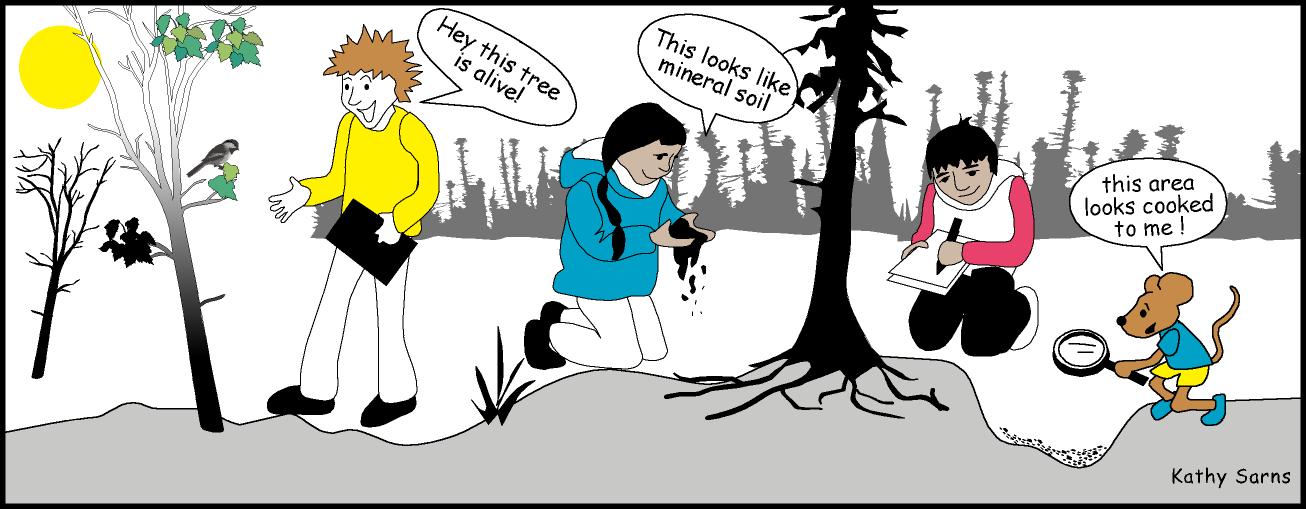
| Grade Level: 4-12 |
| Alaska State Content Standards: SA14, SA15 |
| Subject: Science |
| Skills: Observation, Classification, Comparison, Description |
| Duration: 1-2 class period |
| Group Size: whole |
| Setting: outdoors |
| Vocabulary: fire impact, heavily burned, moderately burned, lightly burned, fuel, vegetation mosaics, permafrost, active layer, surface fire, canopy fire, crown fire, ground fire, rhizomes, semi-serotinous cones |
OBJECTIVE
Students will describe some of the effects of fire on a boreal forest or tundra ecosystem.
TEACHING STRATEGY
Students will investigate real or hypothetical burn sites.
MATERIALS
FIELD NOTEBOOK - ![]() Tundra Burn Site OR
Tundra Burn Site OR
![]() Boreal Forest Burn Site
Boreal Forest Burn Site
TEACHER BACKGROUND
Tundra Burn Site
Fire impact is the overall effect of a fire on an
ecosystem, including the effect on vegetation and soils. Fire impact is determined by the amount of
organic soil material (decaying plant and animal matter, roots, etc.) removed
by a fire. The condition of the organic
soil material will determine the kind of vegetative growth that will occur
following a fire. Fire impact is
classified in three levels:
- Heavily Burned - Most or all of the organic material in the soil is burned and the remaining soil is charred and dark. A heavily burned area may have had soils with a thick organic layer and low soil moisture. All the plants have been burned, and there is a deep, mineral-rich ash layer present. Fires can bake soils to a point where they will not absorb water, which may increase the potential for erosion.
- Moderately Burned - Some of the organic material in the soil is burned. Some woody twigs of plants are present. These fires do not seriously affect the quality of the soil. Erosion may occur to some degree.
- Lightly Burned - Plants may be charred or scorched. Mosses and twigs are still visible. Some mosses and other plants have turned brown or yellow.
Fuel is any material that will burn. The type and quality of fuel determines how hot a fire will burn and the effect the fire will have on the habitat. A build-up of organic material and brush will fuel a hot surface fire. Highly flammable fuels allow hot ground fires to start and spread quickly. These fuels include shrubs of the heath family, such as Labrador tea, which contain a highly flammable, oily sap. Grass fires are generally fast burning, but cool, and do less damage to the organic layer of the soil than more intense shrub fires.
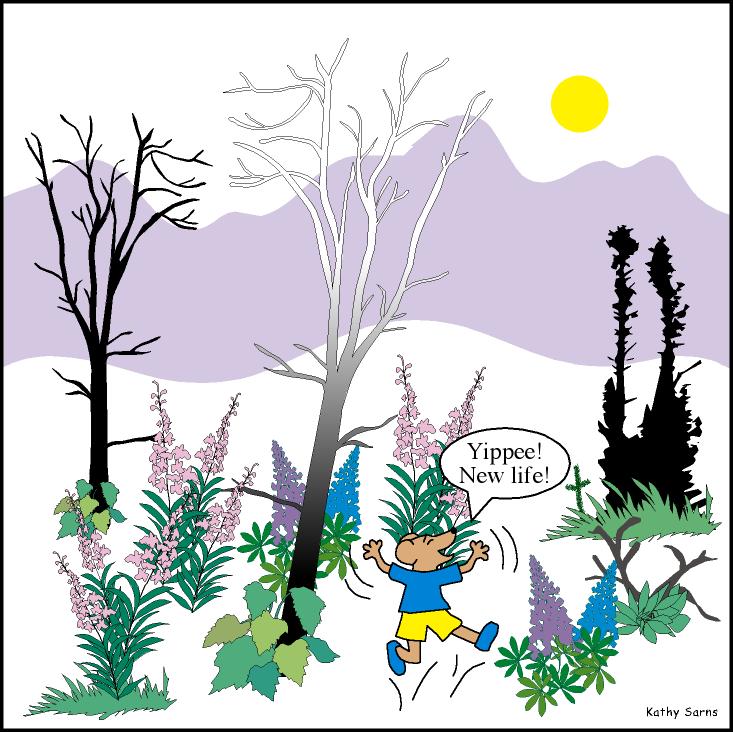
In a lightly to moderately burned area, seeds and roots buried in the remaining organic layer will revegetate rapidly, sending up new shoots. Plant nutrients in the form of ash are put back into the soil, resulting in rich new plant growth. Grass and sedge tussocks quickly sprout new shoots. Herbs and shrubs come back from rhizomes (underground, root-like stems), roots, and seeds. Plant species with deep roots, such as wild rose and Labrador tea, are less likely to be damaged by moderate intensity fires and will re-sprout quickly. Shrubs such as willows sprout from stumps as well as from roots.
In heavily burned sites, plants and roots are destroyed. New growth depends on unburned seeds buried in the organic layer or those brought in from other areas by animals or wind. The high concentration of minerals in the heavily burned soils provides a good seed bed for the germination of seeds. Grasses, herbaceous plants such as fireweed and horsetail, and mosses are some of the first plants to begin growing in bare, mineral soils. Most of the same plants that grew in the area before the severe fire will return; however, species percent composition may be different.
In tundra areas, most fires burn lightly due to lack of fuel. Thus, the extensive underground parts of most tundra plants usually survive fire. Their roots usually re-sprout within a year after a fire. Little change generally occurs in the species of tundra plants following a fire. Most tundra sites return to their pre-burn appearance and productivity in less than ten years. The return to pre-burn appearance takes more time in tundra areas where lichens dominate. Lichens are often entirely consumed, even by light fires. Since lichens are slow growing and slow to invade burned sites, dense lichen stands may not return to a burned tundra site for 100 years or more.
Fires in the tundra typically burn in a spotty, erratic pattern, leaving islands of vegetation unburned. This creates a vegetation mosaic of plants representing different tundra plant habitats.
Fire can also have effects on areas of permafrost, or permanently frozen ground. The active layer, the layer of soil that freezes and thaws each year, insulates permafrost. Fire removes the plants and organic matter and exposes the active layer. This exposed layer absorbs more of the sun's heat, and the depth of the active layer increases. This can affect soil drainage by indirectly causing the permafrost to melt and creating wet meadows, ponds, and even small lakes.
The effects of tundra fires on wildlife are often short-lived. The lush plant growth following a fire can lead to higher populations of plant-eating animals such as lemmings and voles. These provide abundant food for foxes, weasels, and beavers. Scientists disagree about the effects of tundra fires on caribou. Since these animals eat lichens for winter food, some scientists are concerned that fires may reduce the amount of winter habitat for them. In areas where tundra fires lead to formation or maintenance of wetlands and ponds, waterfowl and other aquatic animals such as beavers and muskrat may benefit.
Boreal Forest Burn Site
Fire Impact is the overall effect of a fire on an
ecosystem, including the effect on vegetation and soils. Fire impact is determined by the amount of
organic soil material (decaying plant and animal matter, roots, etc.) removed
by a fire. The condition of the organic
soil material will determine the successional stages that occur following a
fire. Fire impact is classified in three levels.
- Heavily burned -- Most or all of the organic material in the soil is burned and the remaining soil is charred and dark. A heavily burned area may have had soils with a thick organic layer and low soil moisture. All the plants have been burned, and there is a deep, mineral-rich ash layer present. Fires can bake soils to a point where they will not absorb water, which may increase the potential for erosion.
- Moderately burned -- Some of the organic material in the soil is burned. Logs may be deeply charred. Some woody twigs of plants are present. These fires do not seriously affect the quality of the soil. Erosion may occur to some degree.
- Lightly burned -- Plants may be charred or scorched. Mosses and twigs are still visible. Some mosses and other plants have turned brown or yellow. Logs are not deeply charred. Fire-resistant trees will not be seriously affected.
This classification system illustrates how a surface fire can have a greater effect on the forest floor than a canopy (crown) fire. In some instances, a canopy fire may burn the leaves and branches of trees, but do little harm to the soil. (The activity "How Hot is it?" will acquaint the class with the characteristics of surface, ground, and canopy fires.)
Fuel is any material that will burn. The type, quantity, and arrangement of fuel determine how hot a fire will burn and the effect the fire will have on the habitat. A build-up of organic material and brush will fuel a hot surface fire. Highly flammable fuels allow hot ground fires to start and spread quickly. These fuels include shrubs of the heath family, such as Labrador tea, which contain a highly flammable, oily sap. Grass fires are generally fast burning and do less damage to the organic layer of the soil than a more intense shrub fire. Because the live foliage of deciduous trees is more fire-resistant than that of spruce, canopy fires are more likely among spruce than deciduous trees. Regardless of fuel type, fire intensity is also affected by other factors, such as moisture and topography.
In a light to moderate burned area, seeds and roots buried in the remaining organic layer will revegetate rapidly, sending up new shoots. Plant nutrients in the form of ash are put back into the soil, resulting in rich new plant growth. Grasses and sedges quickly sprout new shoots. Herbs and shrubs come back from rhizomes (underground root like stems), roots, and seeds. Shrub and tree species with deep roots, such as wild rose and Labrador tea, are less likely to be damaged by moderate intensity fires and will re-sprout quickly. Shrubs such as willows sprout from stumps as well as from roots.
Light and moderate intensity fires, if they do not burn long in the area, can be beneficial to the habitat. These fires do not generate high soil temperatures, which destroy all plant life, and they return important nutrients to the soil. Frequent, low (or light) intensity fires help prevent the build-up of fuels. When fuel is allowed to accumulate, intense fires may result during a dry year. It takes years for the soil and vegetation to recover from such fires.
In heavily burned sites, plants and roots are destroyed. New growth depends on unburned seeds buried in the organic layer or those brought in from other areas by animals or wind. The high concentration of minerals in the heavily burned soils provides a good seed bed for the germination of these seeds. Grasses, herbaceous plants such as fireweed and horsetail, and mosses are some of the first plants to begin growing in heavily burned sites. Deciduous trees will sprout from roots, stumps, or seeds. Most of the same plants that grew in the area before the fire will return; however, species percent composition may be different.
Fires may not burn an entire area, particularly under wet conditions; they may burn in a "patchwork" pattern, leaving islands of vegetation unburned. This creates a vegetation mosaic of plants in different stages of succession, which supports a wide diversity of wildlife species. New herb and shrub growth provides abundant shoots to feed forest wildlife. Low shrubs are good cover for small mammals.
Some plants have become well adapted to fire. Black spruce trees have cones that remain on the tree for many years. These cones are semi-serotinous. They are sealed with a tough resin and open only when the resin is dried by fire or years of hot summer sun. When a fire burns through a black spruce forest, the cones open and thousands of seeds fall to the ground. If conditions are suitable, the seeds will germinate. White spruce trees lose their cones each year, so they do not have the seed reserve that black spruces have.
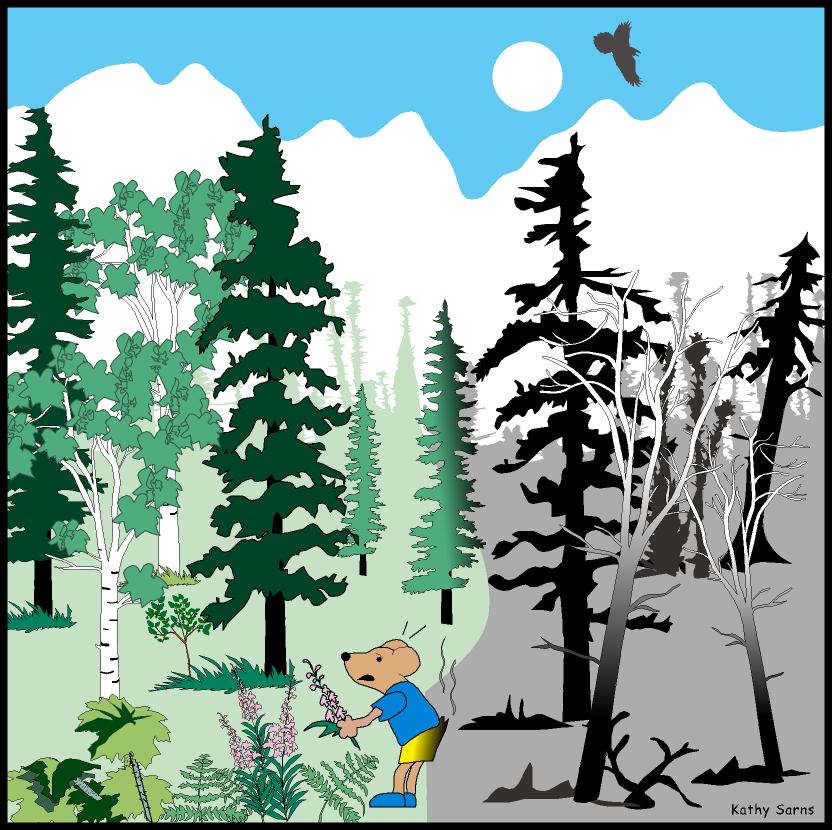
Fire can also have effects on areas of permafrost, or permanently frozen ground. Permafrost is insulated by the active layer of the soil. This is the layer of soil that freezes and thaws each year. Fire removes the plants and organic matter and exposes the active layer. The exposed active layer absorbs more of the sun's heat, and the depth of the active layer increases, making deeper nutrients available to plants. In addition, the burning of the organic layer returns nutrients to the soil. However, thawed soils near a stream or river or on a hill are more likely to erode.
PROCEDURE: Boreal Forest
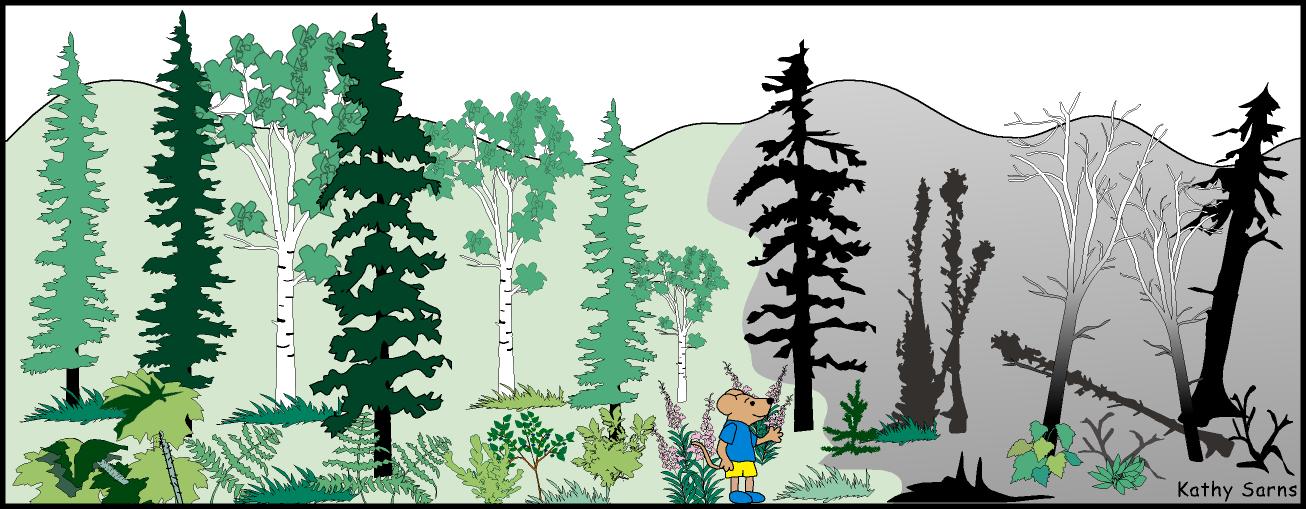
- Visit a burned area. The burn does not have to be recent. Village elders may be able to help locate a burn site that is not recent. Try to answer the questions on the "Boreal Forest Burn Site" worksheet to determine what kind of fire occurred and its impact.
- After answering the questions about the burn site, draw and color how the vegetation might come back or continue growing after the fire.
- Have students share the plants they drew in their burn site picture and why they thought the plants they drew would be the ones to come back to the area.
- If you don't have a burn site, view the videotape "Fire in The Forest" from the Role of Fire In Alaska Kit.
PROCEDURE: Tundra
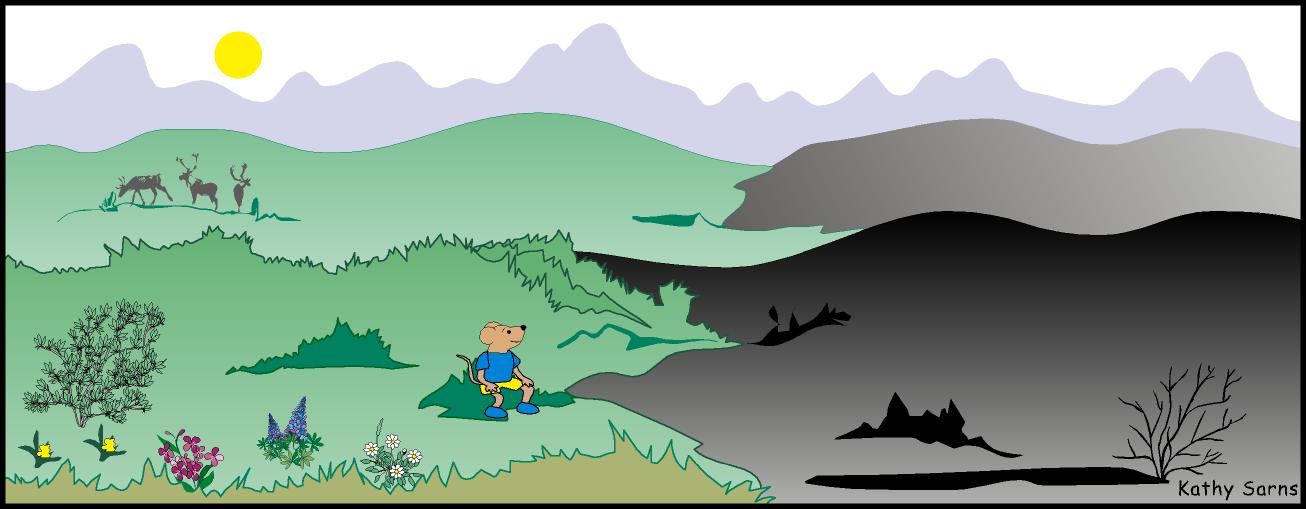
- If possible, visit a burned area. The burn site does not have to be recent. Village elders may be able to help locate burn sites that are not recent. Try to answer the questions on the “Tundra Burn Site” worksheet to determine what kind of fire occurred an its impact.
- After answering the questions about each burn site, draw and color how the vegetation might come back or continue growing after the fire.
- Have students share what plants they drew in their burn site picture and why they thought the plants they drew would be the ones to come back to the area
- If you don't have a burn site, visit any area and try to determine how likely it would be for a fire to occur there. You may want to consider the amount of brush and organic material present. When do you think a fire last occurred in the area?
EVALUATION
- Following discussions, visit another area near your school that has not been burned. Have students try to determine how likely it would be for a fire to occur there. You may want to consider the amount of brush and organic material present. What kinds of trees are present? Deciduous trees or spruce? Would a canopy or a surface fire most likely occur? Based on the area's stage of succession, roughly estimate when you think a fire last occurred in the area.
- Then have students draw, or explain, what they think the area they visited would look like in 50 years.
| Printable version | Add to favorites | Make Alaska FWS my homepage |
| Site designed and maintained jointly by the USFWS Alaska Region Division of Information Resource Management (IRM) and External Affairs (EA). |